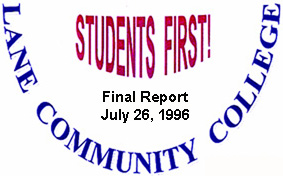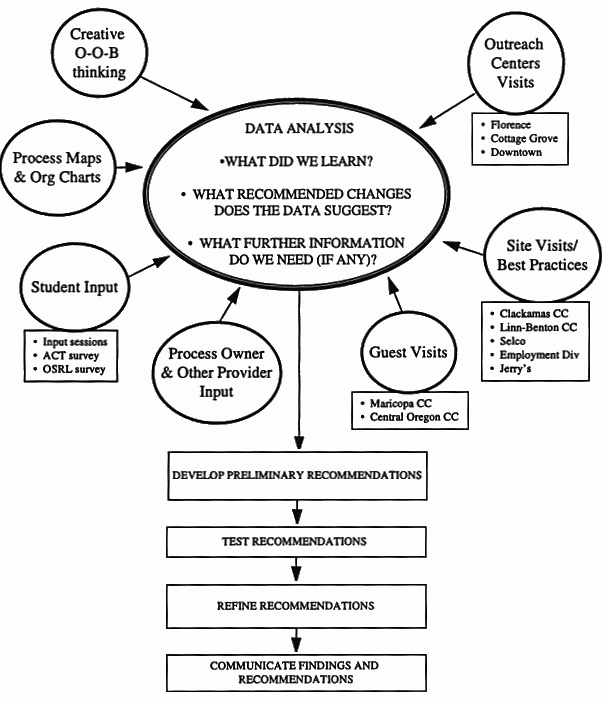
CHAPTER TWO: THE PROCESS
Table of Contents | Main Students First! Page
This chapter describes how Lane evaluated services to students and developed recommendations for change. The actual work of redesigning services to students was performed by the Students First! Redesign Team during the spring and summer of 1996. However, considerable preparation work was performed prior to the creation of that Team.
Preparation for Process Redesign
Lane began preparing to perform process redesign about one year ago. At that time, Lane was becoming increasingly aware of the forces for change described in Chapter One of this report. Lane leadership knew change was needed, but did not wish to engage in a haphazard change effort without clear goals or direction. Rather, Lane leadership decided to undertake a systematic evaluation process to identify those areas where the needs and opportunities for change were greatest.
During the summer of 1995 Lane formed a Process Evaluation and Selection Team (PEST) to conduct this evaluation process. The PEST Team administered a readiness assessment survey to employees to evaluate employee readiness for change. The results of the survey overwhelmingly indicated that Lane was ready for change, with eighty-five percent of respondents stating that they believed change was needed. However, sixty-seven percent of respondents expressed indifference and/or discouragement from previous change efforts. This result indicates the need for any further change efforts to have the sustained support of top management.
The PEST Team evaluated a number of potential processes to undergo redesign including facilities/support, grants/contracts, personnel/payroll, planning/budgeting/financial, procurement, and services to students. Services to students was selected to serve as the pilot redesign project at Lane because it ranked highest in meeting the criteria that the PEST Team had identified for process selection. The PEST Team found that services to students at Lane:
- are highly visible process affecting over 37,000 students/customers each year
- have more than eight different student categories with different objectives, information, and intake functions
- lack consistent, integrated, and seamless delivery of service
- demonstrate uneven application of information technology
- have fragmented departments and programs that cause students to be bounced among service providers before getting the answers they need
- reflect a high level of employee readiness for change
Leadership for Process Redesign
Lane created a seventeen member Process Redesign Leadership Team in September of 1995 to communicate strategic direction and vision for all redesign projects at Lane. The Team's diverse membership represent a wide range of functions and interests. For each redesign project, the Process Redesign Leadership Team is responsible for:
- selecting administrative and students services core processes for redesign, and the order in which they will be conducted
- defining scope limitations and boundaries for projects
- determining internal and external resource requirements
- monitoring overall project progress
- adjusting project approach as needed
- evaluating and recommending new operating policy changes
- reviewing process change proposals and making recommendations to the Executive Leadership Team
- setting performance standards for each process
- setting measurement and rewards for project participants
- developing and implementing change management strategy
- sponsoring campus wide communications
Marshaling Resources for the Pilot Redesign Project
In late 1995 and early 1996, Lane leadership worked to marshal the necessary resources for the pilot redesign process, which came to be known as the Students First! redesign project. Based on conversations with and site visits to other higher education institutions undergoing redesign efforts, Lane leadership realized that the dedicated commitment of a team of individuals over a period of time was critical to the success of the pilot. They decided to create a team of employees to conduct the redesign, and to secure release time for their participation. They identified criteria for team membership, and identified candidates to serve on the team from various levels, skill sets, and functions within services to students at Lane. The ten members of the Students First! Redesign Team, listed in the appendix of this report, together represent seven departments at Lane and include one student.
At the same time, Lane leadership worked to identify facilities, computers, administrative support, and outside advisory services to support the work of the Students First! Redesign Team.
Preparation of the Students First! Redesign Team
By late winter of 1996, the members of the Students First! Redesign Team were ready to begin their work. Their objectives as defined by the Leadership Team were to:
- conduct detailed analysis of current processes
- understand the student/customers' requirements
- provide creative alternatives in redesign
- recommend required process changes
- develop detailed implementation plans
- work with the existing organization to adopt the new process
- identify and report resistance to change
- inform affected departments of project status
To prepare for redesign, the Team first underwent team-building training, in which they developed the following vision, mission, and ground rules or guiding principles.
|
Students First! Vision
Students/customers are successful because:
- Lane provides consistent, accurate, easily understood information about programs and services
- Information and services are readily accessible and meet the changing needs of students/customers
- Employees are empowered to provide quality integrated services
|
| Students First! Mission
To effectively provide our students/customers with the services and materials they need in order to participate successfully in the learning experience provided by Lane. |
|
Students First! Ground Rules
1. Each member of our redesign team will bring and share expertise and knowledge of their department or function. We commit to exchanging information between the Redesign Team and the rest of the college to ensure involvement, respond to concerns, and make good decisions.
2. We strive toward consensus, working for satisfactory solutions in a non-adversarial mode, and we respect each individual's right to abstain. After a decision is made, we agree to respect the process and support the decision outside of the team.
3. The team will ensure that members who are absent receive sufficient information to resume full participation. Members will assume responsibility for anticipated absences.
4. We agree to allow time between discussion and decision making to allow for additional concerns to surface while still moving toward consensus. We encourage each other to express concerns within the team in an atmosphere of safety and respect.
5. We agree to bring our skills and talents together to meet the needs of each situation. We have a commitment to do our individual share to get the work done.
6. Because we will be discussing sensitive issues, the team may occasionally decide to keep certain preliminary discussions confidential.
7. Visitors are welcome to attend any formal meetings as observers.
8. As members of this team, we mutually support each other to resolve issues in our home departments. |
In addition to these ground rules, members of the Team also developed some guidelines for effective work regarding agenda, preparation, process, soul, and timing of their work. To ensure that they adhered to these guidelines, they identified a member or members of the Team to champion each aspect of effective work they had identified.
The Students First! Redesign Team also underwent intensive training in process redesign methodology, tools, and techniques in their weeks together.
Research and Analysis Process used by the Redesign Team
The Redesign Team underwent a systematic and rigorous research and analysis process to develop the recommendations described in this report. The research and analysis process served to validate issues related to services to students that the Redesign Team was already aware of, to provide baseline information for tracking improvements resulting from implementing their recommendations, and to allow for more comprehensive analysis of issues related to services to students than had previously been conducted at Lane. After the team-building and training described above, the team's research and analysis work proceeded in the following seven stages:
- research design - the team considered various alternatives for gathering information and decided on those best suited to their objectives
- data collection - the team gathered information using the techniques of:
- input sessions to hear the perspectives of employees involved in conducting processes about what works well and what needs improvement, and a second series to hear their perspectives on initial findings. One hundred and thirty-one employees representing 38 departments participated in these sessions.
- an input session with students to learn of their needs, concerns, and satisfaction levels
- a statistically significant phone survey conducted by the Oregon Survey Research Laboratory (OSRL) to identify student needs and satisfaction levels
- customized questions on the annual ACT student survey to learn about students' evaluation of specific services
- site visits to Clackamas and Linn Benton Community Colleges to learn of their approaches to improving services to students
- guest visitors from Maricopa and Central Oregon Community Colleges to learn of their process redesign efforts
- site visits to local businesses with reputations for excellent customer service to learn about their practices and innovations, including SELCO, the Employment Development Department, and Jerry's Home Improvement Center
- site visits to the Cottage Grove, Florence, and Downtown Outreach Centers as well as the Linn-Benton Community College's Lebanon Center to learn about serving students in locations other than a main campus
- development of process maps illustrating the tasks performed in each of the major services to students process areas, including information dissemination, financial transactions, enrollment services, and support services
- data analysis - the team analyzed each of these sources of information to establish common themes regarding the need for and alternative approaches to improving services to students
- development of preliminary recommendations - the team developed preliminary recommendations, based on their data analysis
- testing of preliminary recommendations - the team reviewed their preliminary recommendations with groups of employees in affected areas to better understand the implications and feasibility of the recommendations
- refinement of preliminary recommendations - the team refined their preliminary recommendations, based on the additional input received from employees, and developed for each recommendation a detailed description of the current situation, desired situation, proposed solution, and action plan for implementing the proposed solution
- communication of findings and recommendations - the team developed this report to communicate their findings and recommendations to the Lane community
The Team added their creative energy and out-of-box (OOB) thinking to their numerous data sources to develop innovative solutions. This research and analysis process is illustrated in the graphic below:

In addition to this research and analysis process, the Students First! Team attended to several other responsibilities to help ensure the success of the project. These included:
- regular progress reports to the Process Redesign Leadership Team
- two progress reports to the Lane Board
- development of communications for distribution within the campus community, with the assistance of the Institutional Advancement Office
- A series of advertisements for the student newspaper, The Torch
- a series of open houses that any student or employee could attend to share their views with the Students First! Team
- communicating with the Process Redesign Leadership Team about change management issues as they arose or were anticipated
The team devoted eighteen weeks to their work, from the beginning of their training to the issuing of this report. With the conclusion of this research and analysis process, the members of the team will be returning to their regular job assignments at Lane. However, many of them will play an ongoing role as coaches for the implementation specific recommendations, as members of the Implementation Team described in Chapter Five of this report, and as advocates for and teachers about redesign in their own work environments. |


